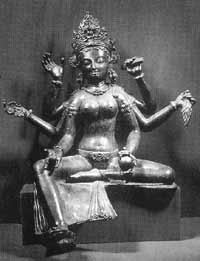
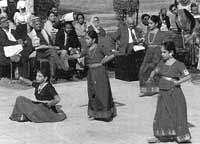

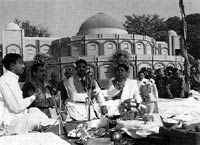
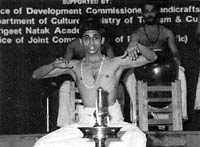
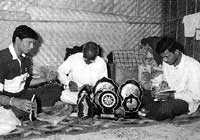
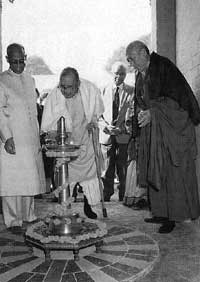
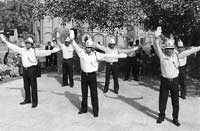
Exhibition
Mudra
The traffic policemen, students of Bharatiya Vidya Bhawan, the Vedic chanters, classical dancers and handicraft artistes were all together present in IGNCA, in the early days of December. What brought them together was Mudra, the multi-dimensional event.
An international seminar, cultural programmes, handicrafts bazaar and a thematic exhibition marked the mega programme ‘Mudra: meaning, metaphor & mystique.’ Conceived by Smt. Sonal Mansingh, Trustee, IGNCA and Chairman, Sangeet Natak Academy, it sought to explore the multiple meanings of the word Mudra. The word, in common understanding means gesture, body posture or a way of conveying a message. However, in Indian thought and tradition, the word assumes several meanings and connotations. Its interpretation varies in cultural, religious, spiritual, political and art contexts.
Inaugurating the exhibition, Rev. Prof. Samdhong Rinpoche, Kalon Tripa, said the word Mudra is important in Buddhist literature and has been translated into Tibetan. He said Mudra means an authentication, a seal that sanctifies or rejects things as Buddhist and non Buddhist. There are four kinds of mudra in Buddhist philosophy. They are karma mudra, dharma mudra, samay mudra andmaha mudra. He explained the significance of each of them and said this event organized by IGNCA was unique as it explored the may facets of the word mudra, which has spiritual, philosophical, cultural and atistic explanations.
Speaking on the occasion, Prof. Vidya Niwas Mishra said mudra is one of the key words in Indian culture. In rituals, it is a very important aspect, he said, Dr. L. M. Singhvi, President IGNCA Trust called mudra a visual feast of emotions, expressions and words, which are silent and eloquent. In the vocabulary of art, mudra-s are expressions, which have been enriched by performing arts he said.
The event got off to an auspicious start with a yajna, on December 3, when the air over IGNCA reverberated with mantra chanting and the fragrance of ghee and other offerings into the yajna fire and incense. Later, the traffic policemen demonstrated the universal ‘mudras’ used in traffic control. The students of Bharatiya Vidya Bhawan presentted through dance-drama the mudra in the daily life, of a child.
The five-day international seminar was inaugurated by Tourism and Culture Minister Shri Jagmohan. Smt. Sonal Mansingh presented a keynote address elucidating the word Mudra, which was followed by a presentation by her titled ‘Setumudra‘.
Through the day, during the five days of seminar (December 3-7) scholars, Vedic chanters, artistes and academicians discussed the different interpretations and applications of the term “mudra” in the diverse domains of knowledge and experience. With the understanding that palpably a whole archive of multi leveled meanings are embedded in the language of mudras, the participants explored the fragmentary clues of simple gesture to the large scale scenario of the hierarchy of sign repertories including its manifestation in philosophy, religion, ritual, artistic expressions, numismatics, linguistics as well as other marks of identity such as modern communication tools and so on.
In the evenings, complimenting the day’s discussions, cultural programmes were presented, which provided the interlink and as such enriched the academic discourse. A play in Malayalam ‘Kalivesham‘ by Kavalam Narayana Panikkar and troupe was presented on December 4. The play is based on the role of ‘Kali’ in the Sanskrit play ‘Nalacharitam‘, the story of Nala and Dhamayanti. The next day, it was a Koodiyattam presentation of ‘Abhigyana Shakuntalaum‘. Here again, the emphasis was onmudra – the hand gestures, the body postures and voice intonations. On Saturday, December 6, the Brajlok Madhuri troupe performed the legend of ‘Amar Singh Rathore, in Nautanki style. The presentation was directed by Pandit Ram Dayal Sharma.
The word Mudra belongs to a general world of concepts and ideas, meandering through several different yet interrelated disciplins. The practical manifestation of this fundamental idea is spread in various areas like dance, dramatic gesture, iconographic representations in sculpture, stamps, seals, written scripts, religious and secular rituals, to communication tools like the bill board and the ad-page. This was the thrust theme of the exhibition held in Mati Ghar, from December 3-30.
The exhibition was curated by Smt. Sonal Mansingh and Smt. Sabiha Zaidi. Photographs, slides, sculptures, paintings, drawings and art objects formed part of the exhibits.
The relation between hand-gesture and creativity was amply illustrated by the artisans at the crafts bazaar that was held in the lawns of IGNCA, sponsored by the Development Commissioner (handicrafts), Ministry of Textiles, Government of India.
Over a hundred stalls offered the best of India’s handicrafts. Some of the items were Naga woodcarving, Madhubani painting, Kalamkari, Kanta stitch, clay moulding, tankha painting, metal craft of Moradabad and the Baster arts.
[ Newsletter | List of Newsletter ]




